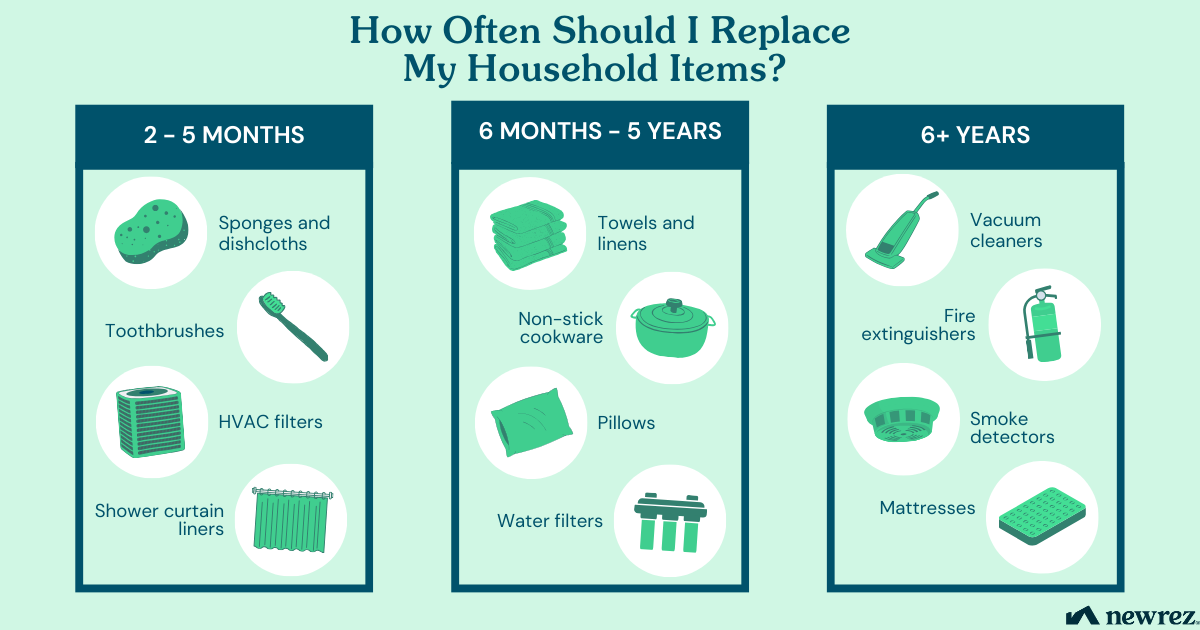Is your vacuum wheezing out dust? Are your linens a little worse for wear? It’s spring cleaning season, which means it’s a great time to take inventory of items in your home and figure out what needs to be upgraded. Boost your quality of life and keep your home safe, clean and cozy by swapping out these items on schedule.

Table of Contents:
-
Non-Stick Cookware
Small Appliances
Cutting Boards
Knives
Sponges and Dish Cloths
Smoke Alarms and Carbon Monoxide Detectors
Let’s start with two of the most important items in your home. These devices keep you and your loved ones safe, so you certainly want them to be in good working condition. Be aware that smoke alarms and CO detectors can lose sensitivity or become faulty as they age.
- Average Lifespan: 8-10 years for smoke alarms, 5-7 years for CO detectors.1
- Signs They Need Replacing: Intermittent chirping even after battery replacement, outdated manufacturing dates on the back, or frequent false alarms.
- Maintenance Tips: Test devices periodically (every month or so) and change their batteries twice a year.
It’s always a good idea to keep a fire extinguisher around in case you need to prevent a small kitchen fire from becoming a major hazard. However, the chemicals and seals on extinguishers do degrade over time.
- Average Lifespan: 10–12 years.2
- Signs It Needs Replacing: Pressure gauge is not in the green zone, visible damage to the nozzle or handle, missing or illegible inspection tag.
- Maintenance Tips: Check the pressure gauge monthly and keep extinguishers in easily accessible locations.
The filters in your heating and air conditioning system are designed to capture dust, allergens and air pollutants. After a few months, they get clogged up and need replacing. Neglected air filters can hinder air flow in your home, reduce your system’s efficiency and result in poor indoor air quality.
- Replacement Frequency: Every 1–3 months for standard filters; high-efficiency filters may last longer.
- Signs They Need Replacing: Visible dust buildup, restricted airflow, or musty odors when the system runs.
- Maintenance Tips: Mark calendar reminders for filter checks, upgrade to high-efficiency particulate air (HEPA) filters if necessary, and schedule annual HVAC inspections.
Home water filters can remove contaminants from your water, but overused filters can build up bacteria and lose their effectiveness.
- Replacement Frequency: 2–6 months, depending on filter type and water usage.
- Signs They Need Replacing: Change in taste or smell, reduced water flow, or visible residue on glasses.
- Maintenance Tips: Follow manufacturer guidelines, flush the system as recommended, and keep track of replacement dates.
Vacuum cleaners are essential home cleaning tools, as they remove dust and allergens from your carpets and floors. But a vacuum cleaner’s suction power and filtration capacity degrade with regular use.
- Average Lifespan: 5-8 years.
- Signs It Needs Replacing: Loss of suction despite emptying the dust canister or replacing the bags, strange noises, frequent overheating.
- Maintenance Tips: Clean or replace filters regularly, empty the dust container after each use, and check the brushes for wear.
A good mattress can significantly improve your quality of life by enabling you to get a good night’s sleep. If you love your mattress, it might be hard to imagine ever letting it go. But over time the mattress will lose its elasticity and become less supportive, and dust buildup could lead to allergens.
- Average Lifespan: 7–10 years.
- Signs It Needs Replacing: Sagging in the middle, visible lumps, persistent back or neck pain upon waking, noticeable wear on the fabric.
- Maintenance Tips: Use a mattress protector, rotate or flip (if applicable) every few months, and vacuum the surface to remove dust.
Bonus Bedding Items: Pillows collect dead skin cells and lose their shape over time and should be replaced every 1-2 years. Linens collect body oils and should be replaced every 2-3 years.
If your kitchen gets a lot of use, it’s important to keep your equipment and utensils in good working condition so that your food is safe, delicious, and preferably un-burnt.
- Non-Stick Cookware: These pots and pans lose their coating over time, resulting in uneven – or even unsafe – cooking. Look for scratches or discoloration of the coating.
Maintenance Tips: Handwash gently, avoid very high heat, and use non-metal utensils.
Replacement Frequency: Every 3-5 years.
- Small Appliances: Blenders, coffee makers and toasters might need replacing if they malfunction frequently or they’re making strange noises.
Maintenance Tips: Clean removable parts thoroughly and descale coffee makers on a regular basis.
Replacement Frequency: Every 5-10 years.
- Cutting Boards: Deep grooves in the board can harbor bacteria, and it might be time to replace it if it’s warped.
Maintenance Tips: Always use separate boards for meat and produce! Hand-wash wooden boards, and sanitize plastic boards in a dishwasher.
Replacement Frequency: Every 1-5 years depending on material and condition.
- Knives: When knives aren’t sharpened regularly and cleaned correctly, they can chip and rust.
Maintenance Tips: Hand-wash and dry promptly, store safety in a block or on a magnetic strip.
Replacement Frequency: When they can no longer be sharpened effectively.
- Sponges and Dishcloths: These common cleaning items harbor moisture that encourages bacteria, even when they look clean.
Maintenance Tips: Disinfect sponges by soaking them in bleach solution and wash dishcloths in hot water every 1-2 days. Allow them to dry completely.
Replacement Frequency: Sponges every 1-2 weeks, dish cloths 6 months to a year.
Shower liners can become a haven for soap scum, mildew and mold if they aren’t cleaned regularly.
- Replacement Frequency: Every 6-12 months.
- Signs They Need Replacing: Visible mold, persistent stains, strong odors.
- Maintenance Tips: Wash fabric curtains regularly and wipe down plastic liners. Allow them to dry completely between showers.
Bonus Bathroom Items: Towels can accumulate bacteria and should be replaced every 2-3 years. Toothbrushes should be replaced every 3-4 months as the bristles fray.
Happy Spring Cleaning!
You take pride in your sanctuary, and that’s why it’s important to replace household items when they’ve reached the end of their useful life. To everyone getting ready to tackle their to-do list, we’re wishing you a spic and span springtime!
Considering kicking off a home remodel, refinancing† your mortgage or buying a new home? Reach out to us today and we’ll be glad to walk you through your options.
References:
1Smoke and Carbon Monoxide Detectors: When to Replace and Recycle - Eco Actions
2How Often Do You Need To Replace A Fire Extinguisher? - Yadkin Fire & Safety




